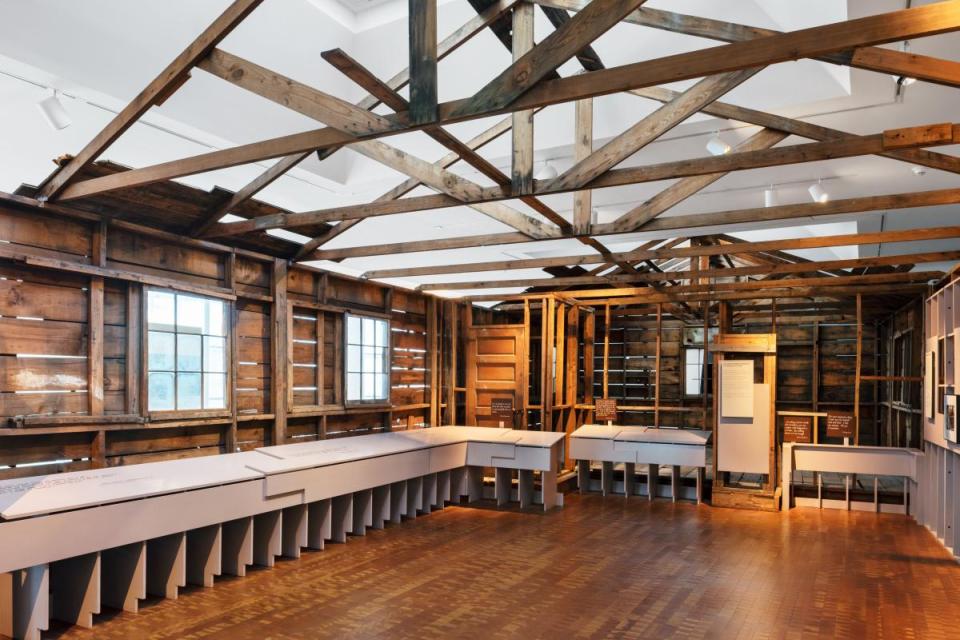即日発表 - 2010年07月16日
プレス連絡先:
Chris Komai - ckomai@janm.org - 213-830-5648

STORY OF RECOVERY OF HT. MOUNTAIN BARRACKS BUILDING TO BE TOLD AUGUST 7, 2010
Fragment of Structure Used to House Japanese Americans Became Symbol of WW II Injustice
The Japanese American National Museum will hold a public program, "16 Years Later: The Heart Mountain Barracks", reflecting on the project that brought to Los Angeles for display a fragment of an original barracks building used to house Japanese Americans as part of their unconstitutional incarceration by the U.S. government during World War II, on Saturday, Aug. 7, beginning at 2 p.m.
In 1994, National Museum staff organized a project to travel to Wyoming to take apart and bring back to the National Museum two fragments of original barracks buildings built by the U.S. government for the Heart Mountain concentration camp during World War II. The project was part of the National Museum’s landmark exhibition, America’s Concentration Camps: Remembering the Japanese American Experience. Dozens of volunteers, many of them former inmates, made the trip. Most were not experienced carpenters, but wanted to help in some way.
Former Heart Mountain camp inmate Bacon Sakatani had located in Wyoming half an original barracks building (a full-size barracks building was 120 feet long and 20 feet wide) that had not been remodeled in the 50 years since the war. It still had some of the original tarpaper on the exterior and all of the original lumber for the walls, floors and roof. Sakatani was convinced that the display of part of an original barracks building would help the National Museum tell the story of the families who were falsely incarcerated by their own government during the war. It would help demonstrate the harsh conditions the families endured living in the 10 War Relocation Authority camps located in desolate areas of the country.
National Museum staff member Nancy Araki organized the project, which recovered two fragments from Wyoming. One fragment was prized for its original exterior, while the second, known as the Ogawa barracks, was recovered for its interior. To help bring both buildings to Los Angeles, Araki engaged preservation architect James McElwain to oversee the logistics of the takedown and reassembling in Los Angeles. She worked with Sakatani and other former inmates to plan the trip. She also recruited contractor David S. Honda, who brought four of his professional carpenters to the project.
The recovery proved to be a major media event when the National Museum discovered that one of the compartment had a family number written on a board. Using the number assigned by the government, the Museum found out that the Mukai family had occupied the space. After a search, the Museum was able to contact one of the children who lived in that compartment, Tomo Mukai. He and his son Ron took part in the project and U.S. national media as well as TV news cameras from Japan documented the story.
Photojournalist Stan Honda documented part of the project and writer Sharon Yamato, who took part in the project with her cousins, authored the book, Moving Walls, which included some of Honda’s photographs. Honda, who also is known for having taken some of iconic images of the 9/11 Twin Towers destruction, will be part of a short program preceding the barracks program on his work on the fateful day. The National Museum’s Watase Media Arts Center produced the documentary, "Eyewitness: Stan Honda", on his experiences and it will be screened at 1:30 p.m.
After dismantling both buildings, the Heart Mountain barracks building fragment was transported on a flatbed truck from Wyoming to Los Angeles. Again, dozens of volunteers, many of them former inmates, took part in the reassembly of the building in the parking lot across from the National Museum. The National Museum built a replica of a guard tower to accompany the historic building and created a replica of the other half of the barracks building (another 60 feet) and attached it to the original structure.
Thousands of visitors came to see America’s Concentration Camps in 1994 and 1995 and the barracks display was one of the highlights. When the National Museum created a traveling version of the exhibition, it was sent to the Ellis Island Immigration Museum in 1998 along with the barracks building fragment. The National Museum was in the process of building its new Pavilion (on the parking lot where the barracks once sat) and when it opened, two compartments (40 feet) of the historic structure were installed inside for display.
The program will include a viewing of the 1994 award winning documentary, "Legacy of the Barracks", created by producer Mark Mohr for KABC-TV Channel 7. A reception will follow the program. Anyone who participated in the dismantling or reassembling of the barracks in 1994 is asked to contact Chris Komai, Public Information Officer, at ckomai@janm.org. Former participants will be admitted free to the program. The program is free to National Museum members or with general admission.

